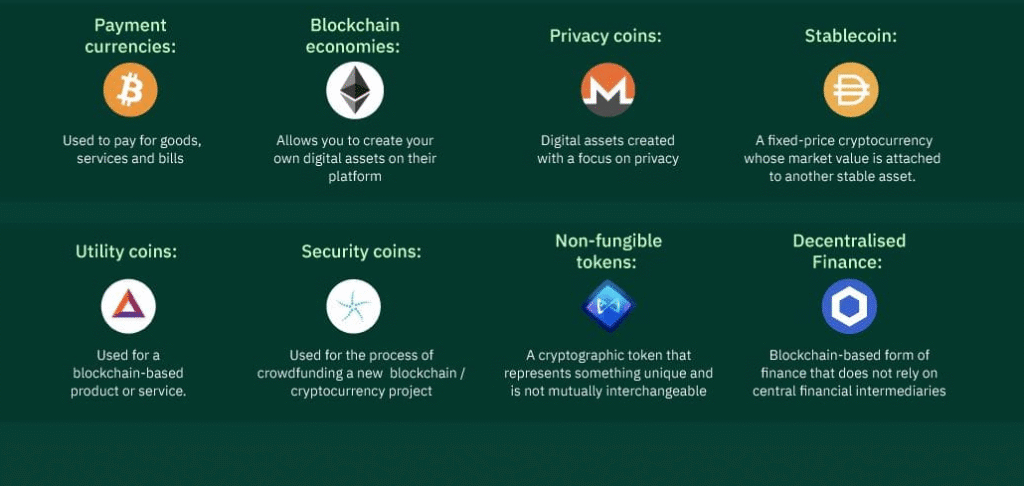Investing in cryptocurrency can be exciting, but it’s also risky due to price volatility. One way to manage that risk is by diversifying your crypto portfolio—spreading your investments across different assets. This beginner-friendly guide will explain what diversification means, why it’s important, and how to do it simply in 2025. Let’s get started!
What is Diversification in Crypto?
Diversification means investing in a variety of cryptocurrencies instead of putting all your money into one, like Bitcoin. It’s like not putting all your eggs in one basket—if one crypto’s price drops, others in your portfolio might hold steady or grow, balancing your overall risk.
In crypto, diversification can include different types of coins, such as established ones (Bitcoin), platform tokens (Ethereum), or stablecoins (USDC), each serving unique purposes.

Why Diversify Your Crypto Portfolio?
Crypto markets are unpredictable, with prices swinging wildly. Diversifying helps beginners invest smarter. Here’s why it matters:
1. Reduces Risk
Not all cryptocurrencies move in the same direction. If Bitcoin crashes, Ethereum or a stablecoin like USDT might stay stable, protecting your portfolio from big losses.
2. Captures Different Opportunities
Each crypto has unique uses—Bitcoin is a store of value, Ethereum powers apps, and XRP enables fast payments. Diversifying lets you benefit from various trends, like DeFi or NFTs.

3. Balances Volatility
Some cryptos, like stablecoins, have steady prices, while others, like Bitcoin, are volatile. Mixing them creates a more balanced portfolio, reducing stress during market dips.
4. Builds Confidence for Beginners
Diversifying feels safer than betting on one coin, making it easier to stick with crypto investing long-term without panicking over price swings.
How to Diversify Your Crypto Portfolio
Ready to build a diversified crypto portfolio? Follow these simple steps tailored for beginners:
Step 1: Start with a Budget
Decide how much you can invest without straining your finances—say, $100 or $500 total. Only use money you can afford to lose, as crypto is risky.
Step 2: Choose a Mix of Cryptocurrencies
Pick a variety of cryptos with different purposes. Here’s a beginner-friendly mix:
- Bitcoin (BTC): A store of value, like digital gold.
- Ethereum (ETH): Powers apps and smart contracts.
- USDT or USDC: Stablecoins pegged to the dollar for stability.
- XRP (Ripple): Fast, low-cost global payments.

Step 3: Allocate Your Investments
Divide your budget across your chosen cryptos. For example, with $500, you might allocate:
- 40% ($200) to Bitcoin
- 30% ($150) to Ethereum
- 20% ($100) to USDC
- 10% ($50) to XRP
Adjust based on your goals—more stablecoins for safety or more Bitcoin for growth.
Step 4: Buy on a Trusted Exchange
Use a reputable cryptocurrency exchange like Coinbase, Binance, or Kraken to buy your cryptos. These platforms are user-friendly and let you purchase with dollars or other currencies.
Step 5: Store Your Crypto Safely
Keep your cryptos in a digital wallet. Exchanges offer wallets, but for long-term safety, consider a hardware wallet (like Ledger or Trezor). Protect your private key at all costs.
Tips for Diversifying Smartly
To make diversification work, follow these beginner-friendly tips:
- Start Small: Begin with a few well-known cryptos to keep things simple and avoid overwhelm.
- Use Dollar-Cost Averaging (DCA): Invest a fixed amount regularly (e.g., $50 monthly) to spread purchases and reduce risk.
- Research Your Picks: Learn the basics of each crypto to understand its purpose and potential.
- Rebalance Periodically: Check your portfolio every few months and adjust allocations if one crypto grows too large (e.g., sell some Bitcoin to buy more USDC).
- Stay Updated: Follow crypto news to spot trends, like Ethereum upgrades or XRP partnerships, but don’t chase hype.

Risks to Watch Out For
Diversification lowers risk, but crypto investing still has challenges:
- Market Volatility: Even diversified portfolios can lose value during market crashes. Be prepared for ups and downs.
- Security: Use two-factor authentication (2FA) on exchanges and secure your wallet’s private key.
- Scams: Avoid unverified coins or platforms promising huge returns. Stick to trusted exchanges.
- Regulatory Risks: Government regulations could affect crypto prices or usage, like XRP’s legal issues.
Why Diversify in 2025?
In 2025, cryptocurrency is more mainstream, with companies like Visa and PayPal integrating crypto and governments exploring digital currencies. Diversifying lets you tap into various trends—Bitcoin’s growth, Ethereum’s DeFi apps, stablecoins’ stability, and XRP’s payment solutions—while managing risk. It’s a smart strategy for beginners navigating this exciting space.

Conclusion
Diversifying your crypto portfolio is a beginner-friendly way to invest smarter in 2025. By spreading your money across different cryptocurrencies, you reduce risk, capture opportunities, and build confidence. Start small, choose trusted coins, and stay patient—your diversified portfolio could set you up for success in the crypto world!
Have questions about diversifying your crypto investments? Drop them in the comments, and let’s keep the conversation going!






















